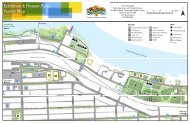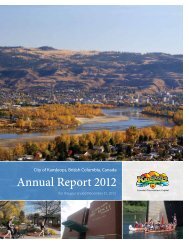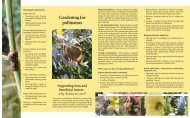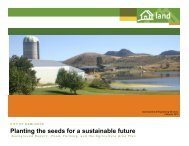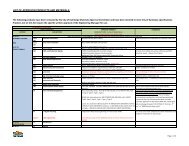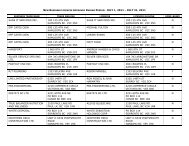GEOTOUR GUIDE - City of Kamloops
GEOTOUR GUIDE - City of Kamloops
GEOTOUR GUIDE - City of Kamloops
You also want an ePaper? Increase the reach of your titles
YUMPU automatically turns print PDFs into web optimized ePapers that Google loves.
(sTop 14) Where does our WasTe WaTer Go?<br />
afTer TreaTmenT, BaCK To The Thompson river<br />
Waste water treatment is a vital part <strong>of</strong> the municipal “water cycle”. When you flush the toilet, where does it go? The answer is the<br />
Thompson River. So how does the <strong>City</strong> manage the waste <strong>of</strong> 85,000 people and protect the environmental quality <strong>of</strong> the Thompson<br />
River? It’s a big challenge!<br />
Figure 55. View <strong>of</strong> sewage lagoons at the <strong>City</strong> <strong>of</strong> <strong>Kamloops</strong> waste water treatment plant west <strong>of</strong> <strong>Kamloops</strong> along the Thompson River. (Photo by R..Turner)<br />
hoW WasTe WaTer TreaTmenT WorKs<br />
<strong>Kamloops</strong>’ waste water treatment relies on an extensive series <strong>of</strong> ponds or “lagoons” excavated into the river plain <strong>of</strong> the Thompson<br />
River. This lagoon complex is the largest municipal lagoon complex in British Columbia. Waste water takes three to four months<br />
to flow through the treatment facility.<br />
As waste water enters the treatment facility, screens remove the large solid objects (it’s amazing what people flush down toilets!).<br />
In primary lagoons, solids settle and bacteria eat the organic wastes. These lagoons lack oxygen and bacteria here are less efficient.<br />
In secondary lagoons, air is bubbled through the water to ensure sufficient oxygen for “efficient” bacteria to live. Most break down<br />
<strong>of</strong> wastes occurs here. Alum (aluminum sulphate) is added to cause fine particles to clump and settle, removing the nutrient<br />
phosphorous from the water. The BC Ministry <strong>of</strong> the Environment closely regulates the amount <strong>of</strong> phosphorous that the waste<br />
water treatment plant releases into the Thompson River. Phosphorous is a plant nutrient, and phosphorous in the river can cause<br />
excessive algae growth. This is a widespread problem in agricultural areas across North America, where agricultural fertilizers that<br />
contain phosphorous leach into waterways. On the Thompson River, this does not appear to be a problem, mainly because <strong>of</strong> the<br />
limited agriculture within the river’s large watershed.<br />
Organic solids that accumulate are removed, centrifuged, and sent to the green waste compost facility across the river (Stop 14).<br />
After composting, they are used on farm fields for growing alfalfa for livestock and municipal parks. The remaining liquids<br />
are disinfected with chlorine and then stored. From April to October treated waste water is pumped through pipes under the<br />
Thompson River, to farm fields where waste water is sprayed on hay and alfalfa fields. In winter, the waste water is discharged into<br />
the Thompson River.<br />
Figure 56. Bubblers within the secondary treatment<br />
lagoon mix oxygen into the wastewater. This oxygen is<br />
essential to sustain bacteria that feed on and digest the<br />
organic matter, converting organic compounds to non-<br />
harmful products. Abundant green algae on the surface<br />
and shoreline plants reflect the nutrient-rich nature <strong>of</strong><br />
the waste water. (Photo by R..Turner)<br />
How to get to tHe wastewater treatment plant: The <strong>City</strong> <strong>of</strong> <strong>Kamloops</strong> waste water treatment plant<br />
is on Mission Flats Road west <strong>of</strong> downtown along the Thompson River. The entrance road to the treatment plant is on<br />
the right, just before the entrance to the city landfill. Tours must be arranged in advance with the <strong>City</strong> <strong>of</strong> <strong>Kamloops</strong>.<br />
32




